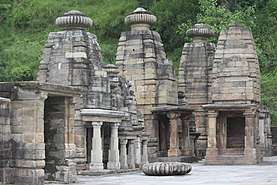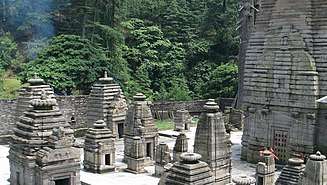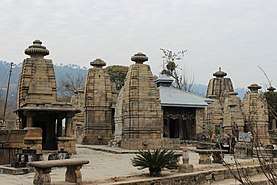Katyuri kings
The Katyuri kings were a medieval ruling clan of present-day Uttarakhand, India. They ruled over the region now known as Kumaon from 700 to 1200 CE.
Katyuri Kingdom Kurmanchal | |
|---|---|
| 700 CE.–1200 CE. | |
| Status | Sovereign state |
| Capital | Baijnath, Uttarakhand |
| Common languages | Kumaoni, Sanskrit |
| Religion | Hinduism |
| Government | Monarchy |
| History | |
• Established | 700 CE. |
• Disestablished | 1200 CE. |
| Today part of | |
Name
They called their state Kurmanchal, the land of Kurma, the second avatar of Vishnu, from which the present name is derived. Their capital was Kartripura.[1]
History
Origin
The exact origin of katyuri kings is unknown, however there have been numerous different claims of origin back to the Kunindas, having found coins from the Kuninda period (Kuninda Kingdom). Rahul Sankrityayan traces their ancestry to Sakas, who were in India before the first century BCE; he further identifies these Shakas with the Khashas.[2] E. T. Atkinson, in the first volume of his book Himalayan Gazetter, proposes that the Katyuris may have been natives of Kumaon, and had roots in the then ruined town of Karvirpur on the bank of Gomati[3],Badri Dutt Pandey, who, in his book History of Kumaon, states the Katyuris to be descendants of the Shalivahan ruling house from Ayodhya.[4][5] Pandey states the Khasas to be the original inhabitants of these Himalayan areas, who settled here before the composition of the Vedas, and the Katyuris to have conquered them, and established their Kingdom.[6]
Kingdom
The Katyuri dynasty was founded by Vashudev Katyuri (sometimes spelled Vasu Dev or Basu Dev);[7] the ancient Basdeo temple in the city - the oldest stone temple in Uttarakhand - is attributed to him.[8] His reign is most commonly believed to be from 850 to 870 CE.[9] The Kingdom was then named Jyotiryana, and had its capital at Joshimath in the Alaknanda Valley.[10] Vasu Dev was of Buddhist origin, but later started following Brahminical practices. The Brahminical practices of Katyuri kings in general is sometimes attributed to a vigorous campaign of Adi Shankara (788-820 CE).[11]
later they shifted their capital to Baijnath from Joshimath[7][4], during their reign they dominated lands of varying extent from the "Katyur" (modern-day Baijnath) valley in Kumaon, between 7th and 11th centuries C.E., and established their capital at Baijnath in Bageshwar district; which was then known as Kartikeyapura and lies in the centre of "Katyur" valley. Brahmadev mandi (a trading and business center in a flat area of the then Katyuri kingdom) in the Kanchanpur District of Nepal was established by Katyuris king Brahma Deo (Brahma Dev). Brahmadeo Mandi still exists by this name.
At its peak, the Katyuri dynasty of kumaon extended from Sikkim in the east to Kabul, Afghanistan in the west, before fragmenting into numerous principalities by the 12th century.[12] it is believed that from king Dham Deo and Vir Deo the downfall of this powerful dynasty began. Virdeo used to collect heavy taxes and forced his people to work as his slaves, King Virdeo teased his subjects by his tyranny to the extent that he forcibly married his own maternal aunt Tila(Tilottama Devi). It is said that the Kumaoni folk song "Mami tile dharo bola" became popular from that very day.[13]After the death of king Virdeo a civil war among his sons started. Fierce fight took place among them. Whole of the kingdom was ruined. The people of this very family divided the whole kingdom among themselves, they declared themselves as independent kings and established their own kingdoms on various parts of kumaon[8][4],
King Brahmdeo of this very family (after whose name Brahmdeo Mandi was founded) established his kingdom in Sui. His first fort lay in Sui and the Rawat king of Dumkot was under him. The second branch started ruling Doti. The third established itself at Askot. Fourth settled down at Baramandal. The fifth maintained its sovereignty on Baijnath and Danpur. The sixth branch ruled in Dwarahat[14], later they were displaced by Chand kings.[15][16]
Later offshoots
The Rajwar dynasty of Askot in Pithoragarh, was set up in the 1279 AD, by a branch of the Katyuri Kings,[11] headed by Abhay Pal Deo, who was the grandson of Katyuri king, Brahm Deo. The dynasty ruled the region until it became part of the British Raj through the Treaty of Sugauli in 1816, Doti the another branch of katyuri dynasty came under Nepal through Gorkha expansion in 1790 and Sugauli treaty.[17]
Rulers
The period of certain Katyuri rulers, is generally determined as below, although there is some ambiguity in respect to exact number of years ruled by each King.
- Vasu Dev (700- 849 CE)
- Basantana Dev (850-870 CE)
- Kharpar Dev (870-880 CE)
- Abhiraj Dev (880-890 CE)
- Tribhuvanraj Dev (890-900 CE)
- Nimbarta Dev (900-915 CE)
- Istanga (915-930 CE)
- Lalitasura Dev (930-955 CE)
- Bhu Dev (955-970 CE)
- Salonaditya (970-985 CE)
- Ichchhata Dev (985 -1000 CE)
- Deshat Dev (1000 -1015 CE)
- Padmata Dev (1015-1045 CE)
- Subhiksharaja Dev (1045-1060 CE)
- Dham Dev
- Bir Dev (Very short period)[18]
Legacy
Architecture
The Katyuri Kings were known for constructing several temples in present-day Uttarakhand and they followed Brahminical practices.[19] Most of the ancient temples in the present-day Uttarakhand are the result of architectural contribution by Katyuri dynasty.[20] Vasu Dev temple at Joshimath, several shelters and small shrines along the route to Badrinath, as well as the Lakulesha, Mahishasuramardhini, Navadurga and Nataraja temples at Jageshwar were constructed by Katyuri Kings.[21] Bhuv Dev (955-970) was follower of Brahminical practices and built several temples at Baijnath and Bageshwar, but the structures are lost and tradition continues.[17] A relatively rare Surya temple, is located at Katarmal, now a remote village near Kosi, which was built by Katarmalla, a lesser known Katyuri ruler and the temple has 44 carved temples around the main temple, but is in a state of neglect after the theft of an important idol.[22] The Katyuri Kings also build a temple known as Manila Devi near Sainamanur.
References
Notes
Citations
- Royle, John Forbes (1839). Illustrations of the Botany and Other Branches of the Natural History of the Himalayan Mountains (etc.). Allen.
- Handa 2002, pp. 22–26
- Handa 2002, p. 24
- Pande 1993, p. 154
- Handa 2002, p. 25
- Pande 1993, p. 152
- Handa 2002, p. 25
- Handa 2002, p. 26
- Handa 2002, p. 26
- Handa 2002, p. 24
- Handa 2002, p. 26
- "9th-11th century". Archived from the original on 20 April 2008. Retrieved 9 June 2008.
- Handa 2002, pp. 34–45
- Hāṇḍā, Omacanda (2008). Panorama of Himalayan architecture. Indus. ISBN 978-81-7387-212-9.
- Srinivas, Vijay. Jewel of the sacred Himalayas. OCLC 1010658966.
- Atkinson, Edwin T. (Edwin Thomas) (1990). Himalayan Gazetteer. Cosmo. OCLC 183008777.
- Handa 2002, pp. 34–45
- Handa 2002, pp. 30–31
- Handa 2002, pp. 34–45
- "Historical Background". Uttarakhand Open University. Archived from the original on 14 June 2013. Retrieved 29 June 2013.
- Handa 2002, pp. 34–45
- Sajwan, Venita (17 August 2002). "A lesser-known sun temple at Katarmal". The Tribune. Retrieved 8 July 2013.
Bibliography
- Malushahi: The Ballad of Kumaon by Mohan Upreti. New Delhi, Sangeet Natak Akademi, 1980.
- Handa, O. C. (Omacanda) (2002). History of Uttaranchal. New Delhi: Indus Publishing. ISBN 9788173871344.CS1 maint: ref=harv (link)
- Pande, Badri Datt (1993). History of Kumaun : English version of "Kumaun ka itihas". Almora: Shyam Prakashan. ISBN 81-85865-01-9.CS1 maint: ref=harv (link)


